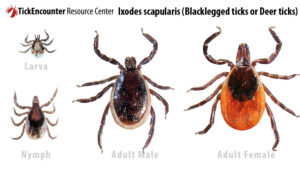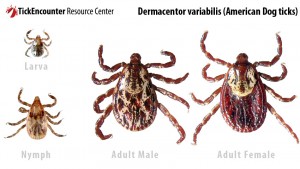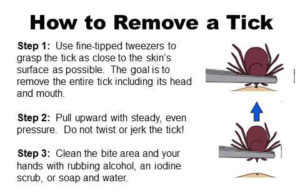What a lovely spring we’re having this winter! This warm weather is making us all dream of afternoons spent hiking, swimming, and biking. Of course we want to bring our furry best friends along! With the weather warming up, it’s time to start thinking about tick prevention, especially if you chose to stop using flea and tick preventatives during the winter.
First and foremost, pick a flea and tick preventative product and make sure you are using it correctly and regularly! At Market Street, we recommend Bravecto for your dogs. It’s a simple “treat” that you give your dog once every 3 months, as opposed to the typical monthly preventative. Bravecto gives your dog 12 weeks of protection from fleas, deer ticks, American dog ticks, and brown dog ticks. In addition, it also gives 8 weeks of protection from lone star ticks.
Once you’ve picked your tick preventative, it’s time to brush up on your tick knowledge. In Loudoun County, there are 3 common types of ticks: black-legged (deer) tick, lone star tick, and american dog tick. You are likely familiar with the deer tick, as that is the type that transmits Lyme disease. Deer ticks are very small and can be hard to see. They are typically 2.7mm! Lyme disease is, unfortunately, very common in Loudoun County. As many as 1 in 4 humans are diagnosed with Lyme disease in our county alone. For dogs, Lyme disease is the most common tick born disease. In addition to correctly administering your dog’s tick preventative, you may also want to consider the Lyme vaccine. The Lyme vaccine is initially given in two doses about 3-4 weeks apart. After the initial dose, it needs to administered yearly.
The lone star tick carries a lesser known, yet still dangerous, disease called ehrlichiosis. To learn more about ehrlichiosis, check out this link. Lone star ticks are larger than deer ticks and the female ticks can be easily recognized by white star or dot on the center of their backs.
The American dog tick is probably the most common tick you will see on your pets. Roughly the same size as the lone star tick, the American dog tick is responsible for transmitting Rocky Mountain Spotted fever. While this is a less commonly seen disease, it is still seen in this area. To learn more about rocky mountain spotted fever, read this article.
Now that you have a general idea of the most common ticks in Loudoun County and some of the diseases they carry, what do you do if you find a tick on your pet? The best way to remove a tick is to use a pair of fine tipped tweezers. Grab the tick as close to the skin as you can and pull up with gentle, but forceful, and even pressure. Make sure you don’t twist the tick, as the could leave the head behind. After you remove the tick, you may want to clean the area with a mild soap and water. If you are unable to identify the type of tick, place it in a plastic, ziptop bag and you can bring it in to our clinic for one of our technicians to identify it. If you are unable or uncomfortable removing the tick, give us a call and we can schedule a technician appointment to help you. Be sure to check your dog for ticks frequently and check especially well after going on walks in the woods.
So, in summary, how can you help prevent tick born diseases?
1. Correctly administer your pet’s tick preventative.
2. Consider getting the Lyme vaccine for your dogs.
3. Check your pet for ticks daily.
4. Promptly remove any ticks that you find on your pet.
Enjoy this amazing weather!!





